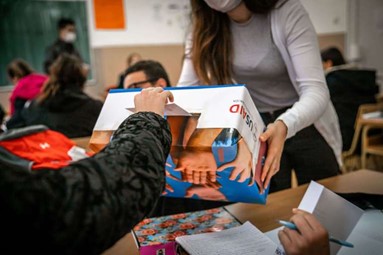We spoke with Natalia Vîlcu, a Moldovan lawyer and Dexis Chief of Party for a USAID project that works to improve the performance of judicial courts in delivering quality justice services to Moldovan citizens. The United States supports the Republic of Moldova’s Western trajectory by helping strengthen its democratic institutions and advance judicial reform.
Q: Thanks for speaking with us today, Natalia. First, can you describe the project you’re leading?
A: The Model Court Initiative (MCI) is the first task order under USAID’s Effective Justice Contract in Moldova. It creates judicial centers of excellence that provide community-responsive services. Specifically, the project supports Moldovan district courts in achieving and maintaining “Model Court” status by boosting efficiency, performance, and quality based on the International Framework for Court Excellence (IFCE), and by tailoring their services to the needs of court users. By first working to pilot user-friendly courts in Balti and Ungheni, we’ve begun to create standards of excellence for other courts throughout Moldova to emulate. The project focuses on the participation of civil society in implementation and in supporting the improvement of local-level court services. Leadership and accountability centers on Pilot Model Courts’ presidents and judges, rather than national-level institutions.
Q: We understand that a well-functioning judicial system is critical for a strong democracy, but why is this specific approach important?
A: According to the latest official data, only 28% of the population of the Republic of Moldova trust the national courts. The negative image centers on perceived lack of independence, inaccessibility, and unfairness of the courts. Trust in judges and courts, however, is vital for social order and acceptance of court judgments. As such, the project’s approach is to change citizens’ perception of the judiciary. The cornerstone of the approach is based on: 1) a focus on court users, 2) accessibility and inclusion, 3) streamlined and simplified court operations, 4) timeliness, and 5) online services.
Q: Got it. So, what do you mean by “user-friendly courts,” and why is your focus here?
A: Let’s take a step back and look at the big picture. How do we transform the justice system so that it works better for us? Instead of thinking of the judiciary as a branch of state power, what if we thought about it as a public service offered to citizens? The idea of creating “friendly courts” starts from rethinking and transforming justice. Any public service from transportation to medicine should be user-friendly, and this is the same for the judiciary. This project helps award the status of “Model Court,” which is achieved when a court demonstrates technical excellence in: 1) quality management, 2) performance, 3) communication (public and media), 4) online services and use of technology, and 5) infrastructure and court facilities.
For example, a Model Court would actively seek feedback from court users, take actions to respond to that feedback, and regularly report on how it responded to the court users’ comments. A high performing court also has a high clearance rate, solving cases within established timeframes and with a limited number of postponements. Model Courts offer the public waiting areas equipped with info-kiosks, comfortable sofas, chairs, and desks, charging stations, and shelving for court materials.
Q: That makes a lot of sense. Are you seeing perceptions of the justice sector change?
Yes! We have worked with the participating courts to host multiple open door events for the public including informal “coffee with a judge” meetings. Students, teachers, public administration representatives, and others have attended these sessions to better understand the role and routine of the judge and ask questions. These are unusual for the courts, and for some citizens, this was their first ever opportunity to speak with a judge. Feedback from visitors has been extremely positive and helped the judges and court staff embrace changes even more.
The project also supports participating courts establishing partnerships with mass media. Initially reluctant, the courts are now regularly sharing information with the media about significant events or high-profile cases. This is a crucial element in shifting public perceptions. We’ve also successfully implemented user surveys as citizens exit the court. This collective input lays the foundation for future court improvements. Now institutionalized in pilot courts, we’ve been working to have user surveys adopted at the national level.
In addition, our team coordinates and supports judiciary reform with local civil society players. For example, a project grantee, the Center for the Rights of Persons with Disabilities (CRPD), has provided free legal aid to persons with disabilities. And the Balti Legal Clinic (BLC) offered free legal aid to over 500 refugees from Ukraine, 90% of whom are women.
Q: That’s great to hear. What are other tangible results you’ve seen, and what does the future hold?
A: We first started with a concept of a model court and examined multiple sources of information and approaches from other countries. Working with our partners, we established a collective vision of what courts could look like by 2024. This vision translates to activities that benefit both courts and users. We’ve given nearly 500 judges and court staff key skills on everything from court workflow management to performance management tools to e-filing.
By analyzing performance data on a quarterly basis, we’ve seen positive changes. For example, as a result of our collaboration, our two Pilot Model Courts in Balti and Ungheni increased their case clearance rates by 9.5%. A real mindset shift has occurred where Consultative Councils of prosecutors, lawyers, and other justice sector players are now proactively identifying problems and solutions. And we’ve just opened a third Pilot Model Court in Edineț District, which will help in extending best practices to other courts in Moldova. Collectively, this will give Moldovan citizens greater confidence that courts are fair and impartial so that they can enjoy increased access to justice.
Natalia Vîlcu, a Moldovan lawyer with over 15 years of experience in human rights and judiciary reform, is Dexis’ Chief of Party on USAID’s Model Court Initiative in Moldova.




